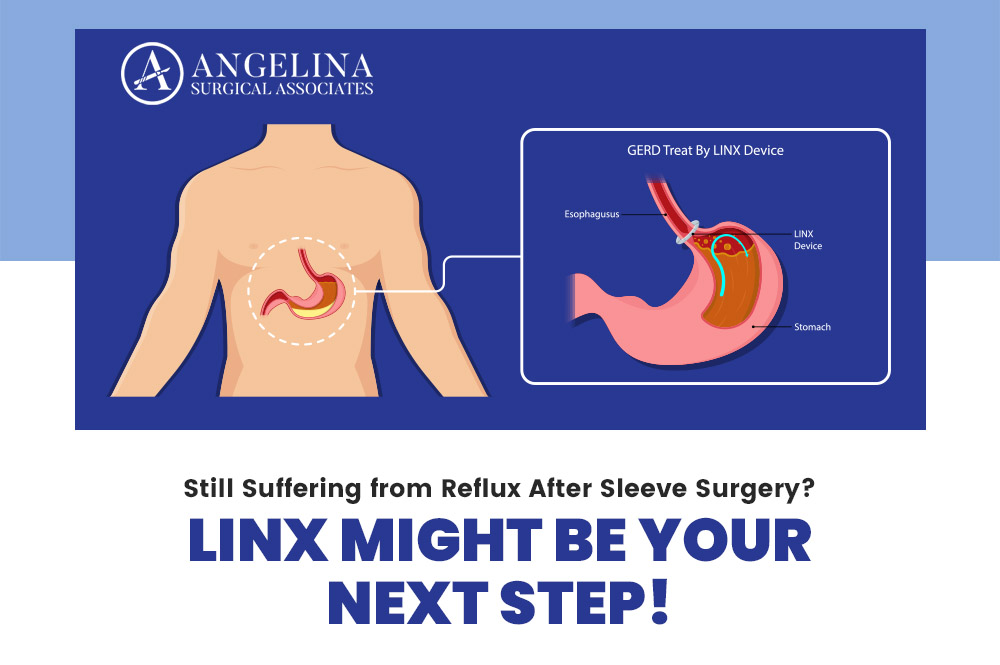Overview: Acid reflux after gastric sleeve surgery can be frustrating. Learn why it happens and how the LINX procedure may offer lasting relief. Read on!
For many people, gastric sleeve surgery is nothing short of transformative. It helps with weight loss, reduces health risks tied to obesity, and often improves conditions like type 2 diabetes and high blood pressure. For countless patients, it’s the beginning of a healthier, more active chapter in life.
But not every outcome is picture-perfect. Some people notice that while the pounds are coming off, another problem starts to take center stage — or gets worse: acid reflux. That burning sensation in the chest, the regurgitation after meals, or the restless nights caused by discomfort can be discouraging, especially after committing to such a big lifestyle change.
If you’re finding yourself frustrated by reflux even after surgery, you’re not alone. And importantly, you’re not out of options. The good news is that medical advances like the LINX procedure offer new hope for patients who thought they’d have to live with reflux forever.
Why Does Reflux Sometimes Persist After Sleeve Surgery?
During sleeve gastrectomy, the stomach is reshaped into a narrow tube. While this helps with portion control and weight loss, it can also reduce the natural pressure that helps keep stomach acid from flowing back into the esophagus.
For some patients, this means that even after achieving weight loss goals, reflux symptoms remain — or, in some cases, become more noticeable. Lifestyle changes, dietary adjustments, and medications like proton pump inhibitors (PPIs) can help, but they may not fully resolve the problem.
Also Read >> Why Heartburn Often Flares Up After Gastric Sleeve & How to Control It
Introducing the LINX Procedure
The LINX system is a small, flexible ring of magnetic beads placed around the lower esophagus during a minimally invasive procedure. The beads are designed to open when swallowing and close afterward, helping to restore the natural barrier against acid reflux.
What makes LINX unique is that it strengthens the body’s natural defenses without significantly altering anatomy. Many patients find that symptoms improve quickly and that reliance on daily medications decreases.
Who Is a Good Candidate for LINX?
If you’re considering LINX after sleeve surgery, here are a few signs it might be right for you:
Persistent reflux despite medication – If PPIs or other treatments aren’t working as well as you’d like.
Daily disruption – If reflux is interfering with your sleep, diet, or overall quality of life.
Post-sleeve reflux that’s not improving – Especially if your surgeon has confirmed that your anatomy is stable and the issue is functional, not structural.
Of course, not everyone will qualify. That’s why consultation with an experienced surgeon is key. At Angelina Surgical Associates, patients can explore whether LINX is a safe, effective next step based on their individual medical history and needs.
What You Can Expect from LINX
Because the procedure is minimally invasive, recovery is generally quicker than with more complex surgeries. Most patients return home the same day, and many notice an improvement in reflux symptoms within weeks.
Perhaps most importantly, LINX can help restore freedom allowing patients to enjoy food again, sleep more comfortably, and live without constant reliance on reflux medications.
Moving Forward
It can feel discouraging to still battle reflux after doing the hard work of undergoing gastric sleeve surgery and embracing lifestyle changes. But solutions exist. The LINX procedure offers hope for lasting relief and a chance to move forward without the daily discomfort of acid reflux.
If you’re ready to take the next step, talking with a surgeon experienced in both bariatric and reflux management is the best place to start. Relief is possible — and you don’t have to keep living with the frustration of reflux.

